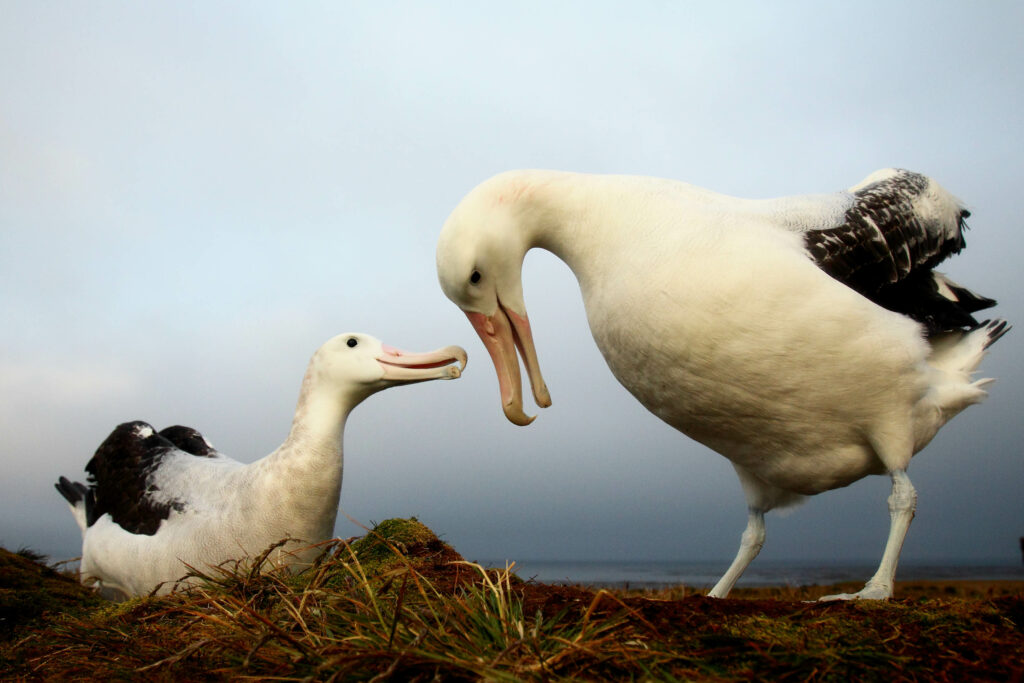Photographer Pierre Pistorius holds a sooty albatross for deployment of a tracking device on Marion Island.
(Ross Wanless)
The largest research project ever undertaken by multiple nations, using tracking data of seabirds and mammals over the entire Southern Ocean, is calling for conservation areas to be urgently established.
The findings from this international collaboration, published in Nature, are intended to inform spatial management across the entire Southern Ocean, to recommend where marine protected areas (MPAs) should be expanded or new MPAs created in areas of national jurisdiction as well as within the high seas where there is no national jurisdiction. The goal is to maximise biodiversity conservation in areas of ecological importance.
 Southern elephant seal subadults with king penguins at Kildakey beach on Marion Island. Tracking data from both species were used in the study published in Nature. (Pierre Pistorius)
Southern elephant seal subadults with king penguins at Kildakey beach on Marion Island. Tracking data from both species were used in the study published in Nature. (Pierre Pistorius)
The call was made in a paper published in the prestigious international journal in 2020, titled Tracking of Marine Predators to Protect Southern Ocean Ecosystems.
The paper reads: “The integration of more than 4 000 tracks from 17 bird and mammal species reveals AESs [areas of ecological significance] around sub-Antarctic islands in the Atlantic and Indian Oceans and over the Antarctic continental shelf. Fishing pressure is disproportionately concentrated inside AESs, and climate change over the next century is predicted to impose pressure on these areas, particularly around the Antarctic continent. At present, 7.1% of the ocean south of 40°S is under formal protection.”
One of the co-authors, professor Pierre Pistorius, who is the head of the marine apex predator research unit at Nelson Mandela University, gives the background: “For many years we have been deploying tracking instruments on seabirds and marine mammals — small GPS units or satellite transmitters — that we attach with waterproof tape on their feathers, and which can be removed easily, or using epoxy glue or darts on seals and cetaceans [whales, dolphins and porpoises]. For this large international study, we only incorporated tracking data from species that have a distribution across the entire Southern Ocean region, such as the wandering albatrosses, macaroni penguins and southern elephant seals.”
“We have been studying the at-sea distribution of these marine predators as they are highly efficient at locating areas of high productivity and rich in food for their survival. These areas are what we call areas of ecological significance (AES). They are productive from the bottom of the food chain to the top, with nutrient enrichment that stimulates phytoplankton growth activity, which leads to zooplankton biomass that moves up the food chain.”
The data reveals that the identification and protection of multiple AESs at ocean scale through the mechanism of multinational MPA expansion is urgently needed to mitigate large-scale resource exploitation pressures on Southern Ocean ecosystems.
 A wandering albatross pair at Marion Island. (Chris Oosthuizen)
A wandering albatross pair at Marion Island. (Chris Oosthuizen)
“We started using this approach, of using tracking data to identify important habitat for conservation purposes, in 2015 when one of my postdoctoral students at Nelson Mandela University, Ryan Reisinger, who is a co-lead author in the Nature paper, focused on tracking data from the Prince Edward Islands that make up South Africa’s subAntarctic territory,” Pistorius explains. “We collated all the historical tracking data by various South African researchers for these islands and through habitat modelling we identified important habitat around these islands to feed into the South African government’s MPA expansion strategy.
“This was then followed up with the global initiative involving multiple nations, where we used tracking data from seabirds and mammals across the entire circumpolar Southern Ocean – across the Indian, Pacific and Atlantic Oceans, in other words, all the water south of 40 degrees. Reisinger led the analysis of all this tracking data.”
 A moulting southern elephant seal male with king penguins at Tripod beach on Marion Island. (Pierre Pistorius)
A moulting southern elephant seal male with king penguins at Tripod beach on Marion Island. (Pierre Pistorius)
Hydro-acoustic ship-based surveys can be used to study the distribution of fish and squid biomass, but because of the massive expanse of the Southern Ocean this becomes logistically and financially prohibitive. Using marine predators as indicators of these biologically rich areas is now well recognised as a feasible alternative with such information guiding marine spatial planning initiatives.
Compliance is a major issue that has to be improved. “Our project is linked to the Commission for the Conservation of Antarctic Marine Living Resources (CCAMLR), which is responsible for the management of the water south of 60 degrees,” Pistorius explains.
“CCAMLR is in a strong position to recommend MPAs for multinational management, which would help to enforce compliance. The information we have gathered has sent clear guidelines to CCAMLR about the need for these MPAs to ensure the long-term sustainability of marine resources, and to prevent overfishing and unsustainable activities.
“Another major challenge we are facing here is that climate change is having a huge impact on Southern Ocean ecosystems. With changing climatic conditions, we are also seeing changes in the distribution of important habitats and these shifts ideally need to be catered for in marine spatial planning initiatives.
“Over and above fisheries and climate-related threats, the world is clearly still very hungry for oil reserves. The establishment of protected areas provides some safeguard against seismic activities and oil extraction in biologically important areas in the Southern Ocean.”